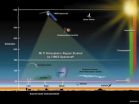New statistical model moves human evolution back 3 million years
2010-11-06
(Press-News.org) Evolutionary divergence of humans from chimpanzees likely occurred some 8 million years ago rather than the 5 million year estimate widely accepted by scientists, a new statistical model suggests.
The revised estimate of when the human species parted ways from its closest primate relatives should enable scientists to better interpret the history of human evolution, said Robert D. Martin, curator of biological anthropology at the Field Museum, and a co-author of the new study appearing in the journal Systematic Biology. Here is a link to the article: http://sysbio.oxfordjournals.org/content/early/2010/11/04/sysbio.syq054.full.html?ijkey=CaQif1LgTAd7xOD&keytype=ref
Working with mathematicians, anthropologists and molecular biologists, Martin has long sought to integrate evolutionary information derived from genetic material in various species with the fossil record to get a more complete picture.
Comparing DNA among related animals can provide a clear picture of how their shared genes evolved over time, giving rise to new and separate species, Martin said. But such molecular information doesn't yield a timetable showing when the genetic divergence occurred.
Fossil evidence is the only direct source of information about long-extinct species and their evolution, Martin and his colleagues said, but large gaps in the fossil record can make such information difficult to interpret. For a generation, paleontologists have estimated human origins at 5 million to 6 million years ago.
But that estimate rests on a thin fossil record. By looking at all of today's primate species, all of the known fossil primates and using DNA evidence, computer models suggest a longer evolutionary timetable. The new analysis described in the Systematic Biology paper takes into account gaps in the fossil record and fills in those gaps statistically.
Such modeling techniques, which are widely used in science and commerce, take into account more overall information than earlier processes used to estimate evolutionary history using just a few individual fossil dates, Martin said. It can give scientists a broader perspective for interpreting data.
One example is a skull fossil discovered in Chad (central Africa) earlier in this decade. The fossil, named Sahelanthropus tchadensis and nicknamed Toumaï (which means "hope of life" in the local Goran language), raised great interest because it has many human characteristics. But consensus on how to classify the discovery has been elusive particularly because the fossil is about 7 million years old, well beyond the accepted time frame for human evolution.
Under the new estimate, Toumaï would fall within the period after the human lineage split from chimpanzees, Martin said.
The new approach to dating evolutionary history builds on earlier work by Martin and colleagues. In 2002, they published a paper in Nature that argues the last common ancestor of today's primates lived some 85 million years ago.
This implies that for 20 million years before dinosaurs became extinct, early versions of primates also lived and evolved. It challenged the accepted theory that primates and other mammals didn't really thrive on the planet until dinosaurs were gone.
After that paper was published, Martin said he expected someone would apply the new statistical techniques to the question of human evolution, but when no one did, "We decided to do it ourselves."
INFORMATION: END
ELSE PRESS RELEASES FROM THIS DATE:
2010-11-06
HOUSTON -- (Nov. 5, 2010) -- A new study by Rice University bioengineers finds that the workhorse proteins that move cargo inside living cells behave like prima donnas. The protein, called kinesin, is a two-legged molecular machine. Rice's scientists invented tools that could measure the pulling power of kinesin both singly and in pairs, and they report this week in Biophysical Journal that kinesins don't work well together -- in part because they are so effective on their own.
"Researchers have been investigating the mechanical properties of individual motor proteins ...
2010-11-06
VEHICLES -- Charge on the fly . . .
A prototype charging system for electric and hybrid vehicles is helping demonstrate a technology that could one day play a key role in the electrification of America's highways. The bench-scale prototype developed at Oak Ridge National Laboratory is allowing researchers to quantify the power transfer parameters necessary to wirelessly charge stationary and moving vehicles. "Our laboratory tests have been successful in transmitting greater than 4 kilowatts," said Laura Marlino of the Energy and Transportation Science Division. "This ...
2010-11-06
Tomas strengthened to hurricane status and is currently lashing Hispaniola and eastern Cuba today and the GOES-13 satellite provided a visible image of its extensive cloud cover.
The Geostationary Operational Environmental Satellite known as GOES-13 captured a visible image of Hurricane Tomas on Nov. 5 at 1331 UTC (9:31 a.m. EDT) centered over the southwestern tip of Haiti. In the image the clouds to the north of Tomas are associated with a cold front off the eastern U.S. coast. GOES satellites are operated by NOAA. The NASA GOES Project at NASA's Goddard Space Flight ...
2010-11-06
Nine years after beginning its unprecedented look at the gateway between Earth's environment and space, not to mention collecting more data on the upper atmosphere than any other satellite, NASA's Thermosphere Ionosphere Mesosphere Energetics and Dynamics (TIMED) mission has been extended again.
Before the launch of TIMED, the mesosphere and lower thermosphere/ionosphere -- which help protect us from harmful solar radiation -- had been one of the least explored and understood regions of our environment.
"The middle part of the atmosphere was the part we kind of ignored," ...
2010-11-06
United States and Japanese researchers have identified a key step in metabolic pathways linked to diabetes and cancer. The study on activation of the protein complex TORC 2 was published online in the journal Current Biology Oct. 28.
TORC 2 activates a protein called Akt, which plays a crucial role in how cells respond to insulin, said Kazuo Shiozaki, professor of microbiology in the College of Biological Sciences at UC Davis and senior author on the paper.
Normally, insulin triggers fat and muscle cells to take up sugar from the blood. Patients with type II diabetes ...
2010-11-06
By tracking the flow of information in a cell preparing to split, Johns Hopkins scientists have identified a protein mechanism that coordinates and regulates the dynamics of shape change necessary for division of a single cell into two daughter cells.
The protein, called 14-3-3, sits at an intersection where it integrates converging signals from within the cell and cues cell shape change and, ultimately, the splitting that allows for normal and abnormal cell growth, such as in tumors.
In a report published Nov. 9 in Current Biology, the Hopkins team links 14-3-3 directly ...
2010-11-06
If you name it, they will use it, according to a team of international researchers who investigated how people perceive the trustworthiness of online technology. In an experiment, participants said they trusted websites, recommendation-providing software and even computers labeled to perform specific functions more than the same Internet tools with general designations, according to S. Shyam Sundar, Distinguished Professor of Communications, Penn State.
"In general, the attribution of specialization can increase the credibility of a product or any kind of object," Sundar ...
2010-11-06
November 5, 2010 -- The devastating 2008 Wenchuan earthquake marks a defining moment for China's earthquake science program. The focus of a special November issue of the prestigious Bulletin of the Seismological Society of America (BSSA), the M 7.9 earthquake has garnered intense interest among seismologists, allowing the Chinese science community to demonstrate its capability to a global audience.
The earthquake produced an enormous disaster, killing more than 80,000 people and leaving more than four million people homeless. Destruction was widespread, though recent ...
2010-11-06
Restaurants could play an important role in helping to reduce the growing obesity epidemic by creating reduced-calorie meals, according to Penn State researchers.
The researchers surveyed chefs, restaurant owners, and culinary executives from across the country to assess their perceptions of serving healthy foods in restaurants.
In the survey, 72 percent of the 432 respondents said they could trim off 10 percent of the calories in meals without customers noticing differences in taste, and 21 percent said they could trim off at least 25 percent of the calories. This ...
2010-11-06
The oldest ground-edge stone tool in the world has been discovered in northern Australia by a Monash University researcher and a team of international experts.
Evidence for stone tool-use among our earliest hominid ancestors dates to 3.4 million years ago, however, the first use of grinding to sharpen stone tool edges such as axes is clearly associated with modern humans, otherwise known as Homo sapiens sapiens.
Monash University archaeologist and member of the team who made the discovery, Dr Bruno David said while there have been reports of much older axes being ...
LAST 30 PRESS RELEASES:
[Press-News.org] New statistical model moves human evolution back 3 million years



